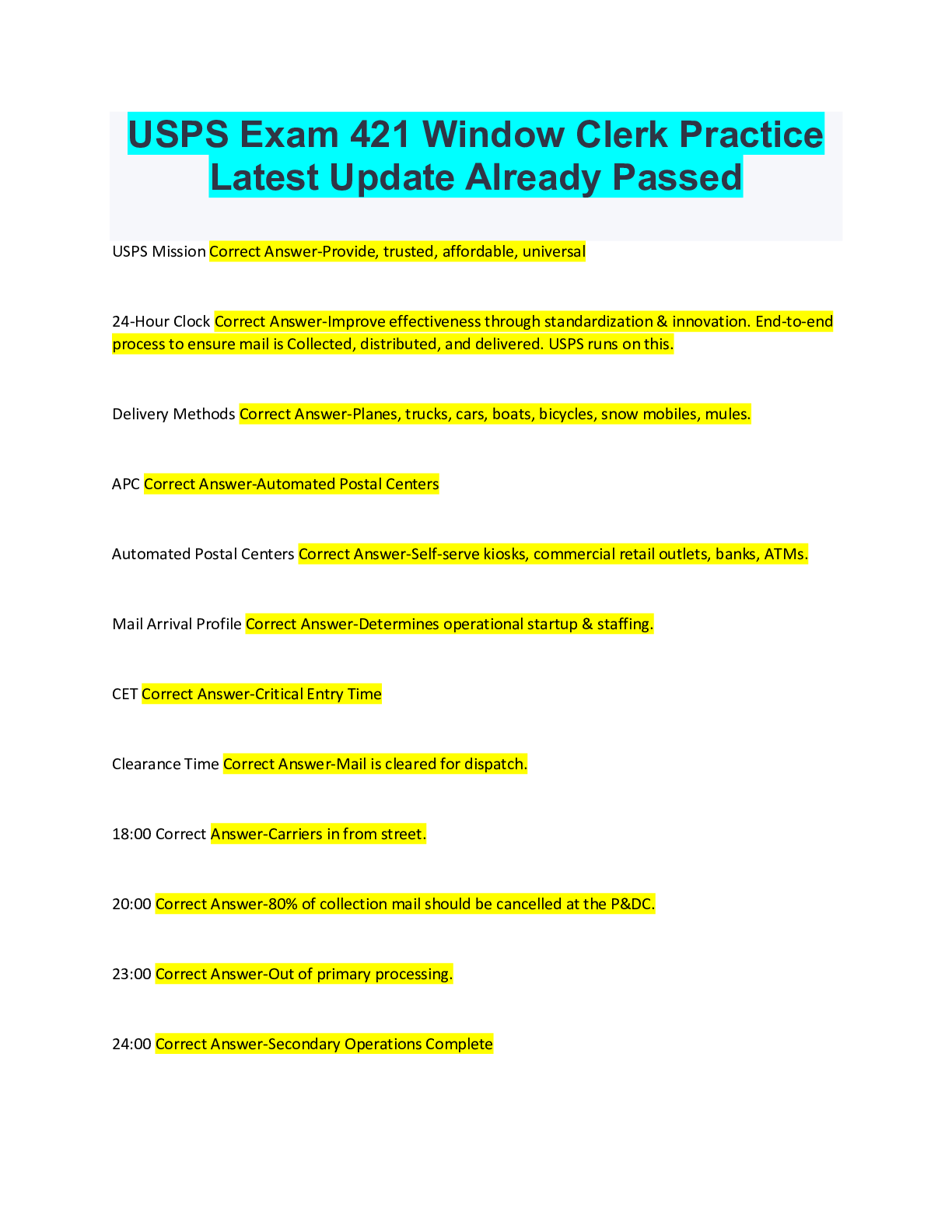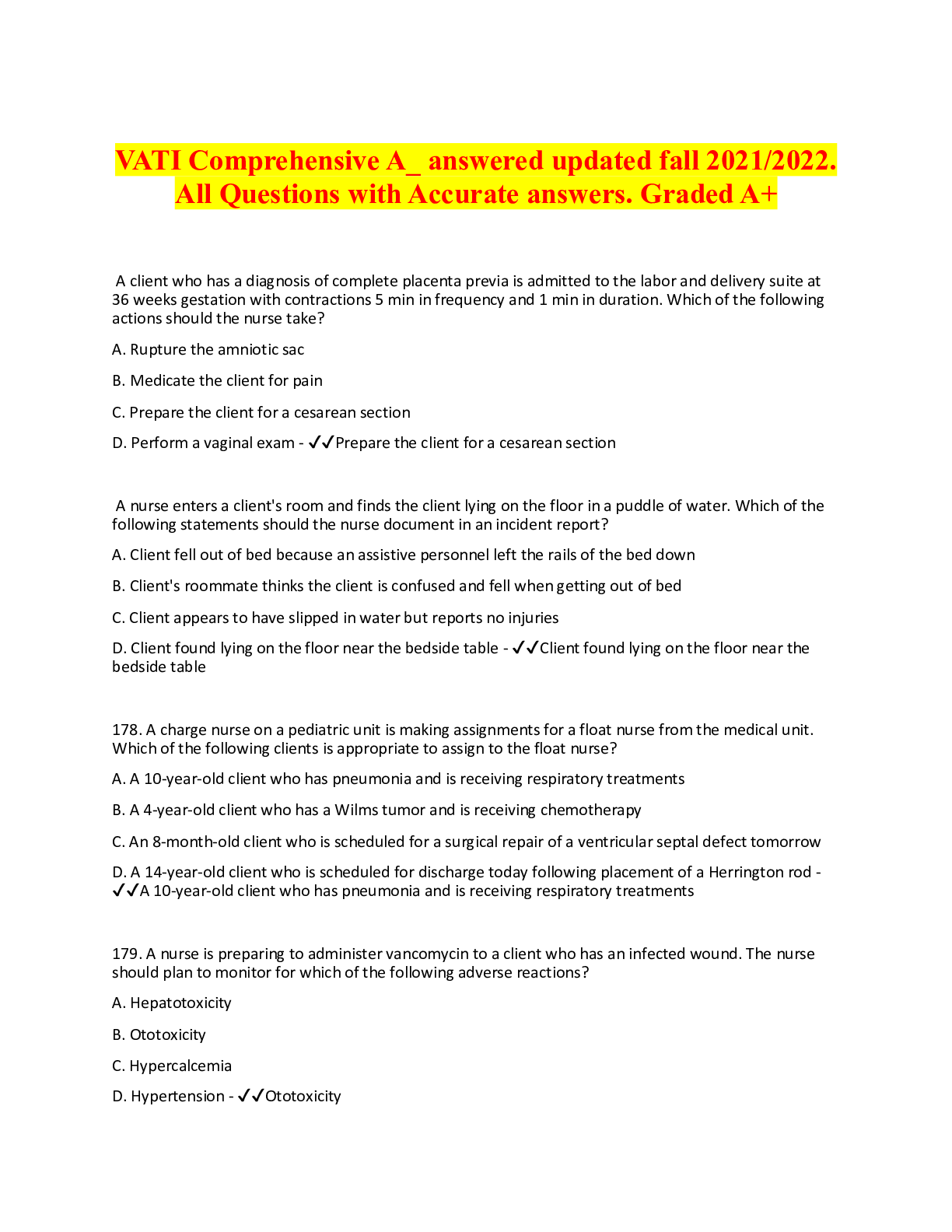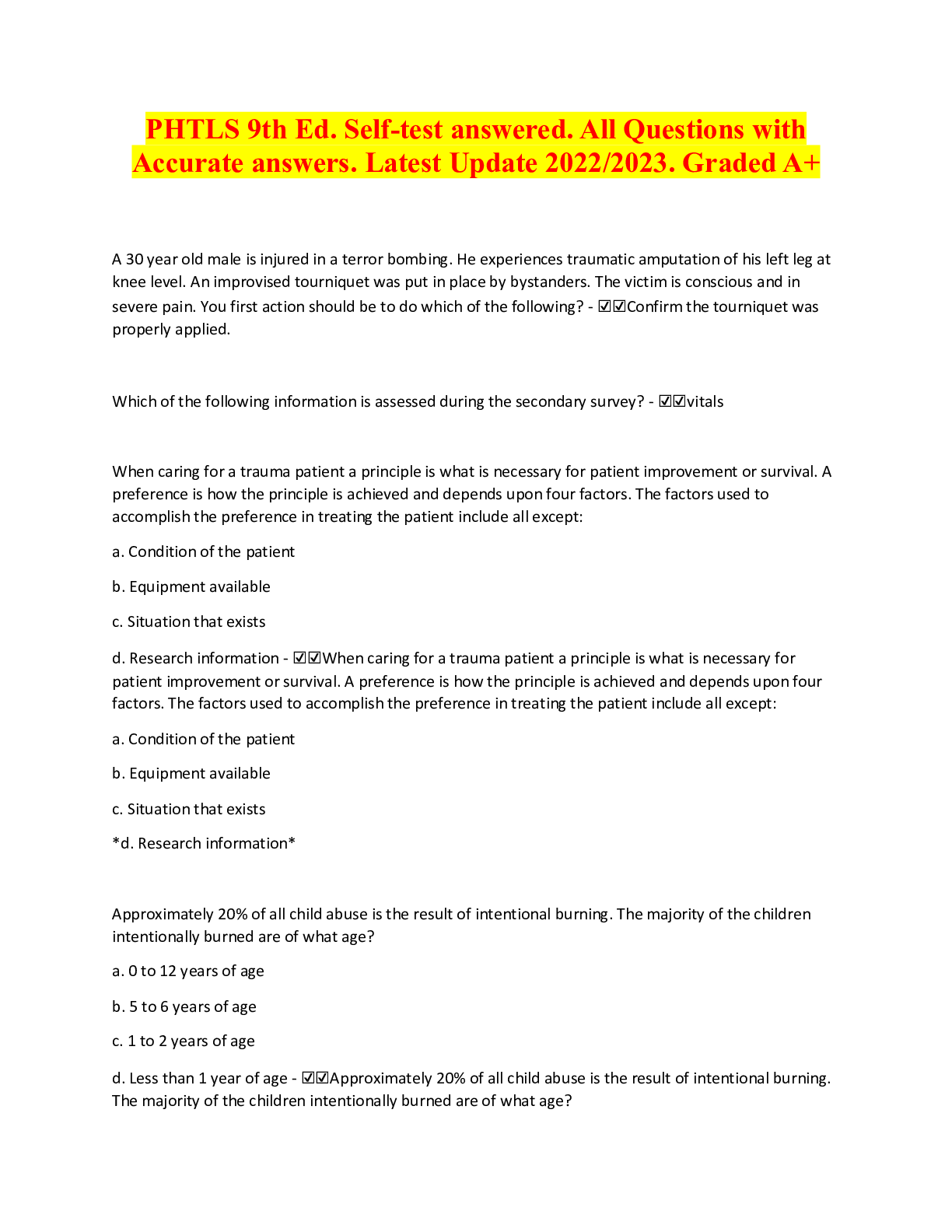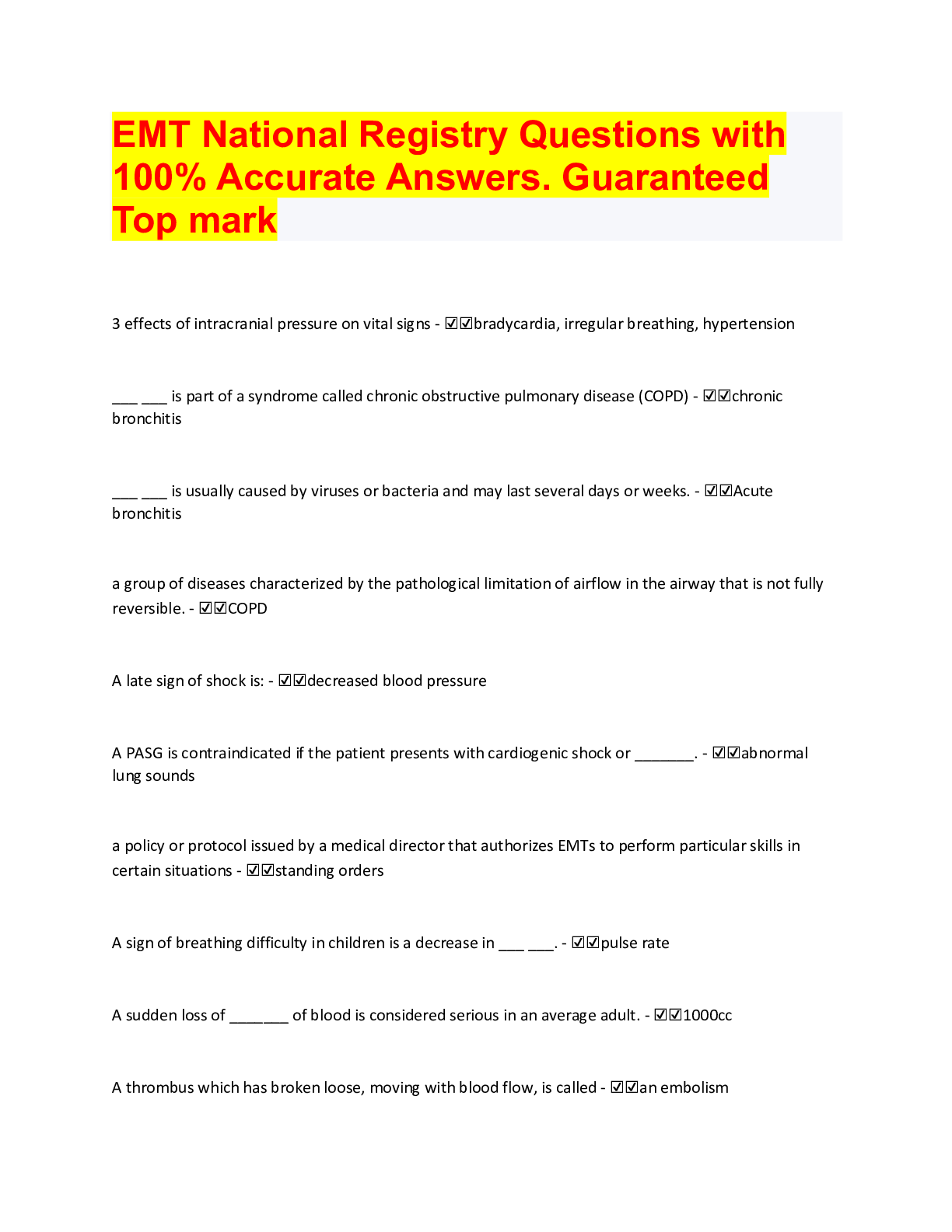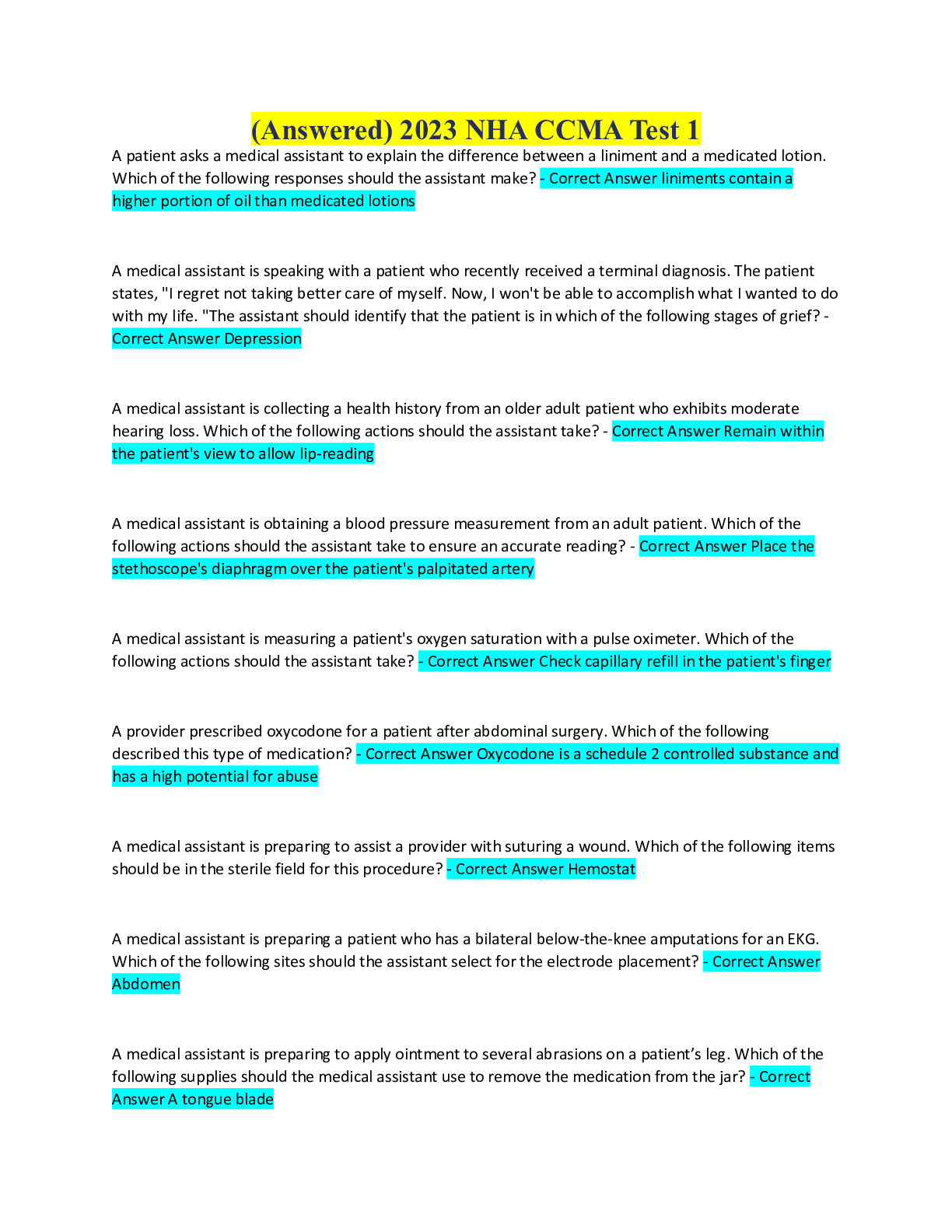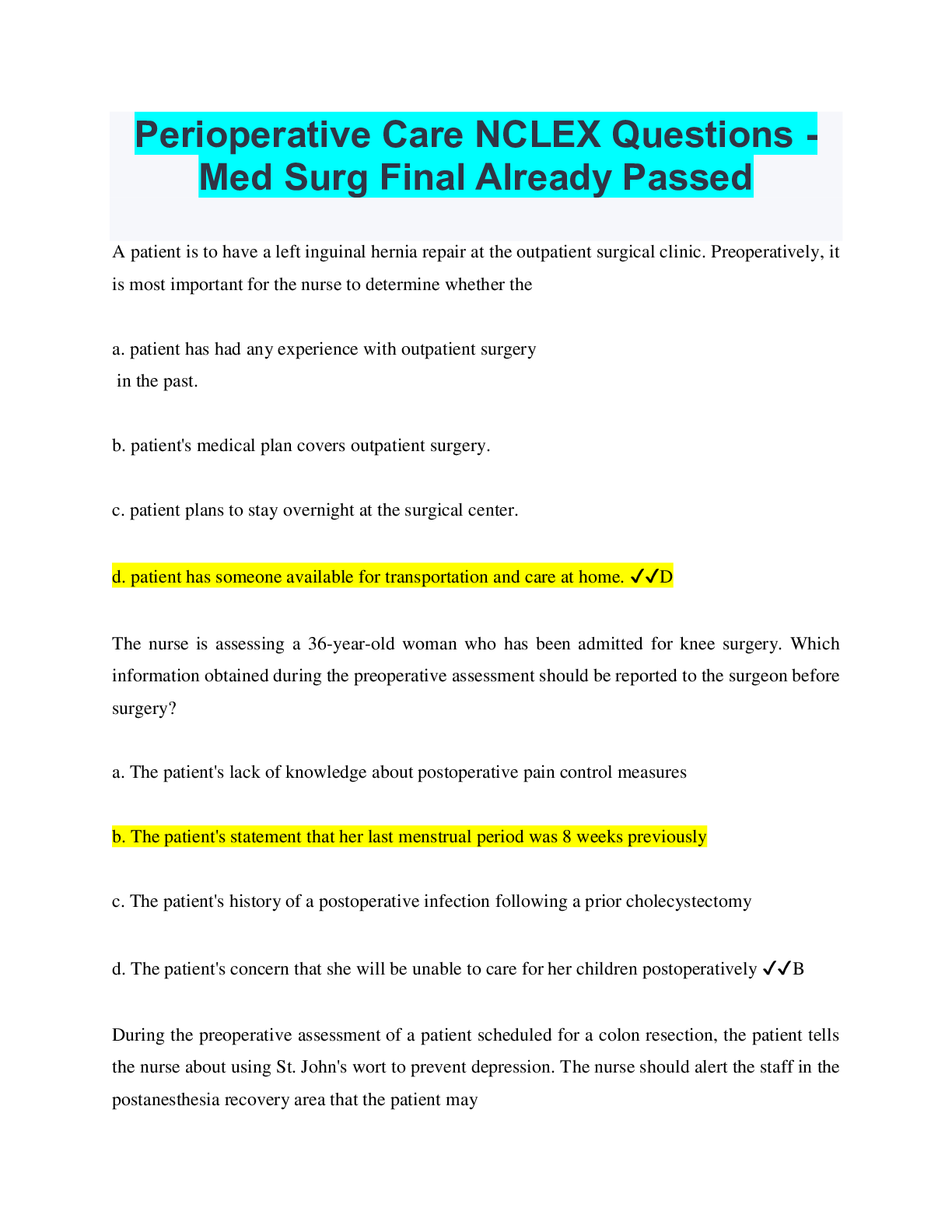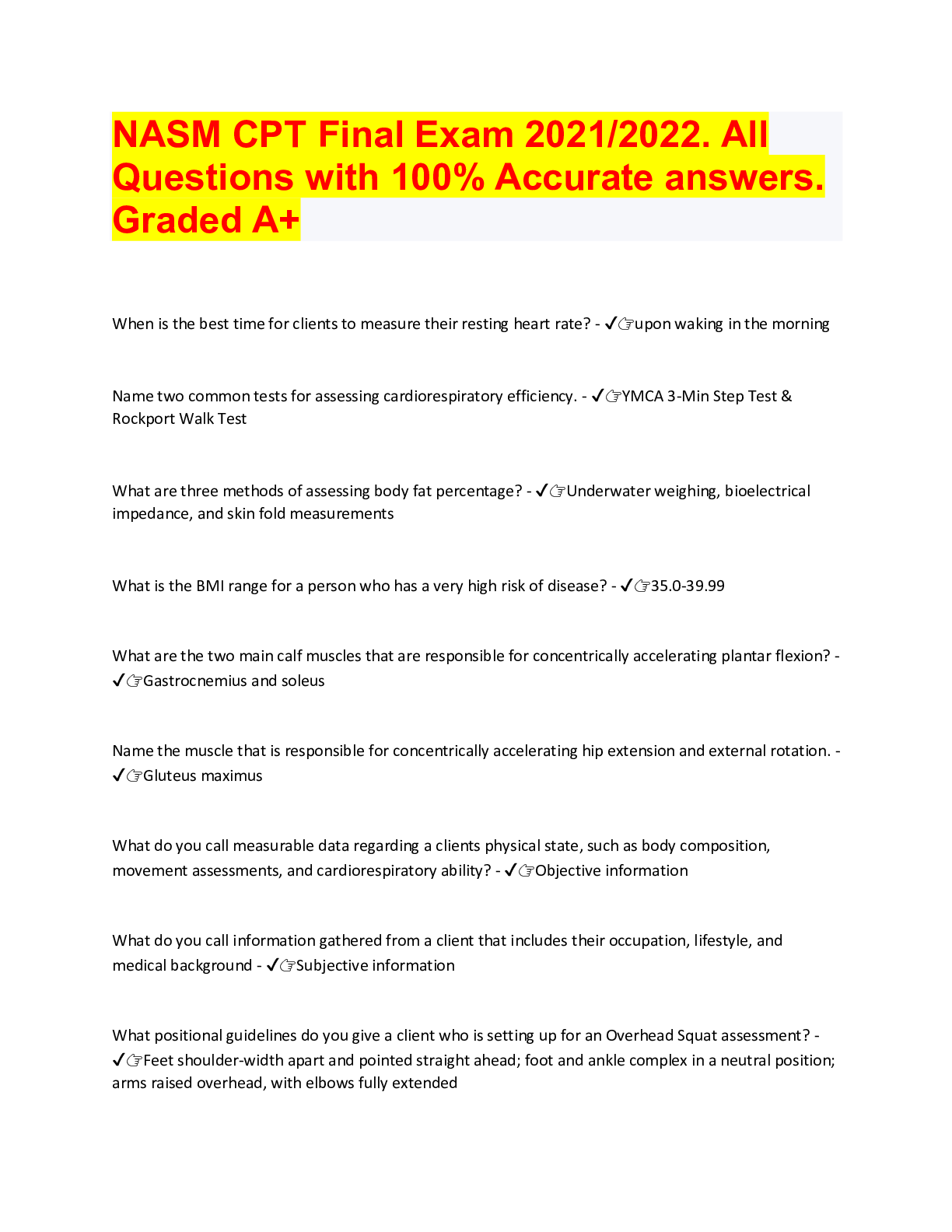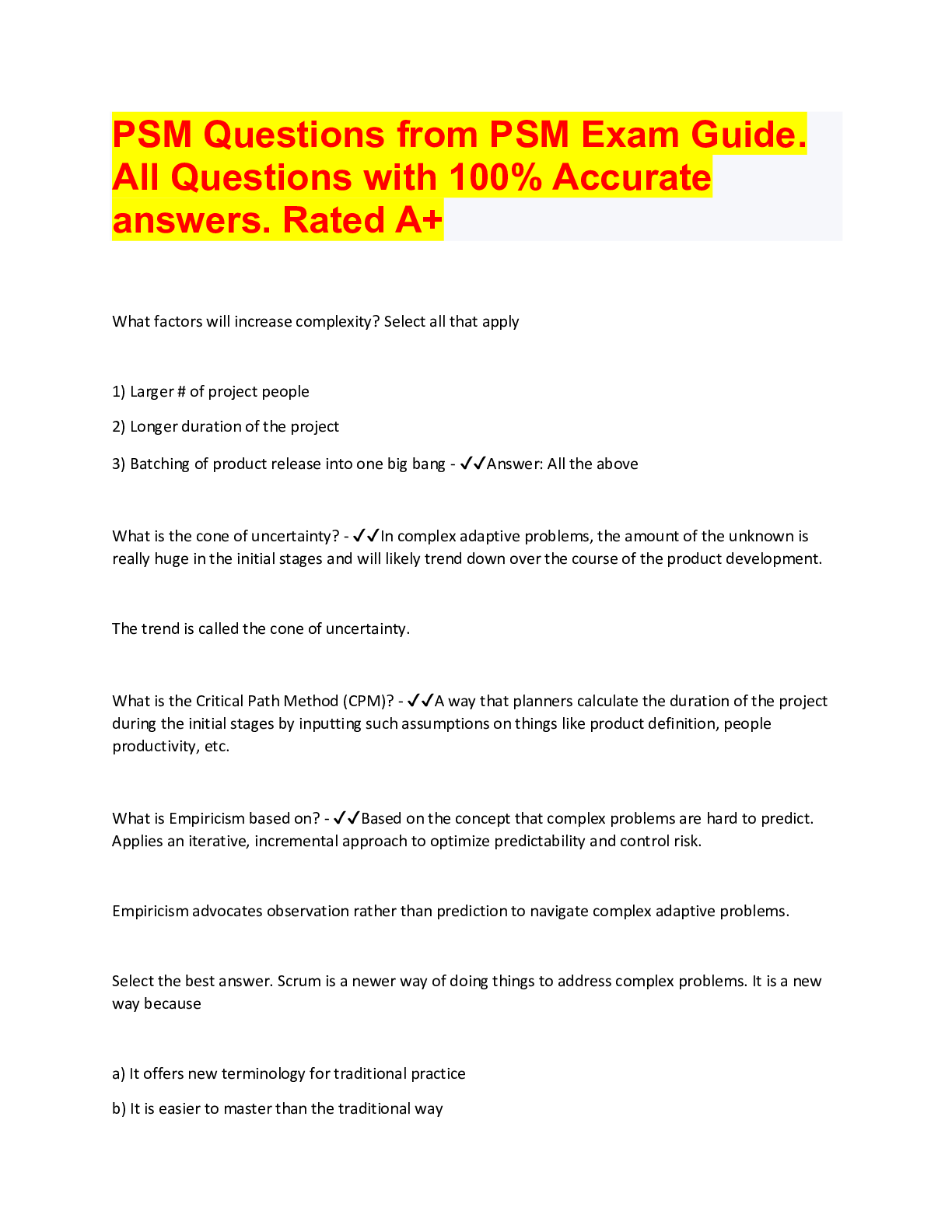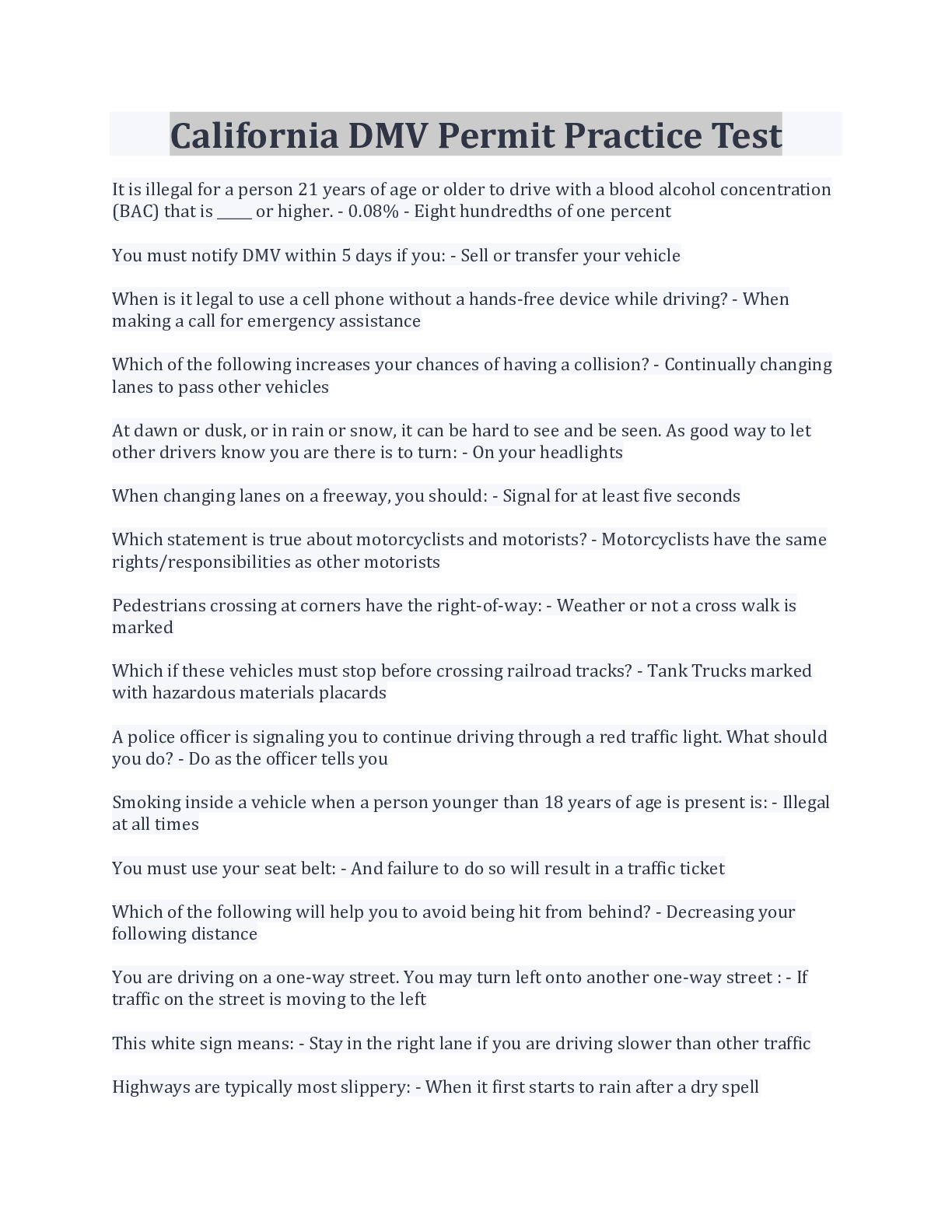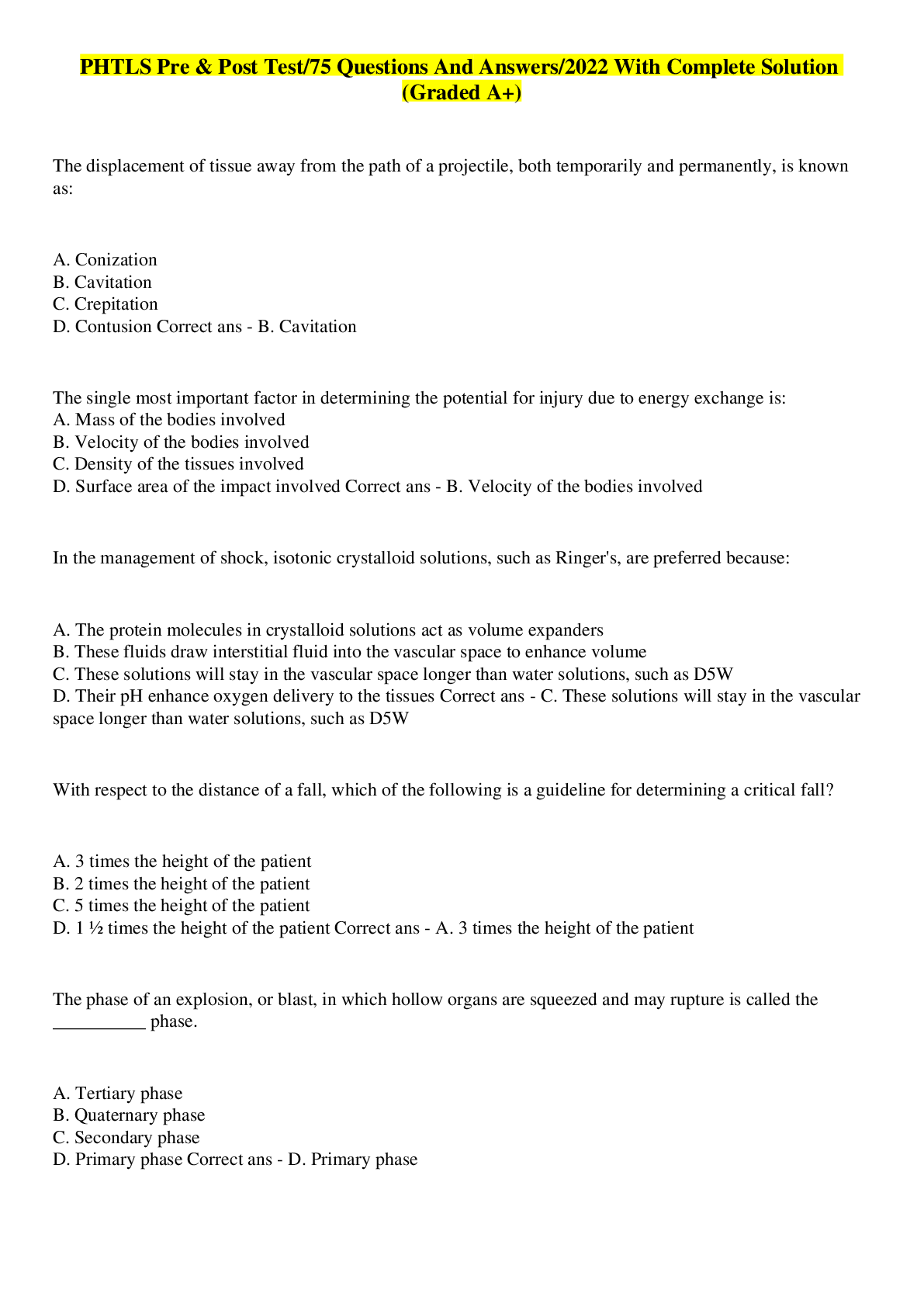*NURSING > QUESTIONS & ANSWERS > NLN-PAX Science. All Questions With 100% Accurate answers. Graded A+ (All)
NLN-PAX Science. All Questions With 100% Accurate answers. Graded A+
Document Content and Description Below
Cell - ☑☑the smallest living unit and the basic unit of function and structure for all living things. Nucleus - ☑☑contains the genetic information, or DNA, and controls the activities of th... e cell. Plasma (cell) membrane - ☑☑separates the contents of the cell from the surrounding fluid (interstitial fluid) Semipermeable membrane - ☑☑refers to the selective nature of the plasma membrane. It contains pores and channels that allow only particles of the right size or the right chemical nature to pass through. Interstitial fluide - ☑☑contains substances such as amino acids, sugars, fatty acids, hormones, neurotransmitters, and salts. Cytoplasm - ☑☑is the fluid matrix found between the plasma membrane and the nucleus that acts as scaffolding for the organelles. Organelles - ☑☑(little organs) are specialized units in the cell that per form certain functions. Mitochondria - ☑☑are the locations for cellular respiration, that is, the conversion of food to energy at the cellular level. The site of energy production and of most of its ATP. ATP (adenosine triphosphate) - ☑☑the chemical the cell uses to store and transfer energy within itself. Ribosomes - ☑☑are the sites of protein synthesis in the cell Endoplasmic reticulum (ER) - ☑☑Ribosomes are attached. Serves as a means for transport within the cell and is made up of many channels. Rough endoplasmic reticulum named for the fact that it has ribosomes on its surface, serves to store and deliver the proteins made by the attached ribosomes. Smooth ER is free of ribosomes it performs varying functions in different cells, including the storage of enzymes and minerals and the folding of proteins, among other things. It is thought to be involved in the detoxification of chemicals and the metabolism of fats. Golgi complex - ☑☑modifies and packages proteins destined for use in the cell or for export from the cell. Lysosomes - ☑☑are sacs that contain strong digestive enzymes. These sacs are responsible for digesting cell structures that are no longer living or that are malfunctioning, and for digesting waste. Cell wall - ☑☑Only plant cells have them. It is responsible for the protection of the cell, the maintenance of the shape, and water balance. Chloroplasts - ☑☑contain chlorophyll, which is necessary for photosynthesis. Vacuoles - ☑☑plant cells also often large ones. Which are compartments in the cytoplasm that act as places for secretion, excretion, and storage. Chromatin - ☑☑DNA is in this loosely structured form when it is not dividing Chromosomes - ☑☑DNA is seen in condensed rod-shaped bodies when the cell is dividing Mitosis - ☑☑When cells divide, the appropriate amount of genetic material must be passed on to the new, or so-called daughter, cells. In somatic (non reproductive) cells, the new cells are identical copies of the parent cells. This is achieved by a doubling of the chromosomes prior to division. It is useful in the growth and repair of our bodies. Zygote - ☑☑the cell created by the union of a sperm and egg contains a full set of chromosomes, half from each parent. Meiosis - ☑☑Another type of division takes place in the production of gametes. It contains half of the normal number of chromosomes. It consists first of doubling of chromosomes and then two subsequent divisions. Thus the products are four daughter cells, each with half the normal number of chromosomes. Muscle tissue - ☑☑skeletal, cardiac, and smooth Epithelial tissue - ☑☑skin, the lining of organs Nervous tissue - ☑☑neurons Connective tissue - ☑☑cartilage, blood, fat, bone Organ - ☑☑performs a specialized function in the body. Organ system - ☑☑made up of a number of organs working together to carry out a major function. Organism - ☑☑the highest level of organization such as the human body Evolution - ☑☑is a theory regarding the processes that have produced the biological diversity we see today. Natural selection - ☑☑the process by which the traits that promote or enhance an organism's ability to survive and reproduce are passed on to following generations. Adaptation - ☑☑For natural selection to occur, organisms must have variations, some of which give the individuals having them an advantage in the struggle for survival. The struggle for survival occurs because each generation of a species produces more offspring than can survive. In this struggle, the individuals best suited to their environment survive ("survival of the fittest") and pass on the traits to their offspring Fossil record - ☑☑consists of remnants or traces of organisms from past geologic ages. Vertebrates - ☑☑animals with backbones Biogeography - ☑☑the geographical distribution of plants and animals Comparative anatomy - ☑☑the comparison of organisms' structures Comparative embryology - ☑☑the comparison of organisms' embryos Molecular biology - ☑☑biology at the molecular level Taxonomy - ☑☑the study of scientific classification. Species are grouped according to their similarities and differences. King Phillip Came Over For Good Soup Kingdom, Phylum, Class, Order, Family, Genus, Species Kingdom - ☑☑animal, plant, monera, protist, and fungi Monera - ☑☑Bacteria Protist - ☑☑Protozoa, algae, and some molds Fungi - ☑☑Molds, muchrooms, yeasts, and the like Active transport - ☑☑involves the use of energy in the form of ATP to move substances across the membrane Passive transport - ☑☑does not require energy and makes use of didffusion and filtration Diffusion - ☑☑particles move in a random manner, spreading evenly throughout an available space and moving from regions of high concentration to those of low concentration. Osmosis - ☑☑A specific type of diffusion is that of water. Water moves from an area of high water concentration (or low concentration) to an area of low water concentration (high particle concentration Isotonic - ☑☑When the solute concentration of the water is the same as that inside the cell. Thus, the amount of water that leaves the cell and the amount that enters it are equal. Hypertonic - ☑☑When the solute is more concentrated outside the cell than inside it. Water leaves the cell due to osmosis; it moves from the high-water/low-particle concentration to low-water/high-particle concentration. As a result, the cell shrinks. Hypotonic - ☑☑If the solute concentration outside the cell is lower than that inside the cell. Water flows into the cell (again high-water/low-particle concentration to low-water/high-particle concentration). If the flow continues long enough, the cell bursts. Filtration - ☑☑the movement of water and solutes through the membrane by fluid, or hydrostatic, pressure. Autotrophs - ☑☑are organisms that produce their own food from inorganic substances. Plants are these. Heterotrophs - ☑☑obtain their food by consuming plants or other animals. They are also referred to as consumers. Primary consumers - ☑☑may be herbivores or omnivores Secondary consumers - ☑☑are carnivores or omnivores that eat herbivores Tertiary consumers - ☑☑are carnivores that eat other carnivores or omnivores Herbivores - ☑☑plant eaters Omnivores - ☑☑plant and meat eaters Carnivores - ☑☑meat eaters Trophic levels and ecosystem - ☑☑These divisions, which are made on the basis of how the organism meets its nutritiional needs. The autotrophs are the most improtant trophic level in the ecosystem and are known as producers; the other levels are mad eup of the different types of consumers. Food chain - ☑☑The path along which food is transferred from level to level. Food web - ☑☑The interrelationship of many food chains Decomposers - ☑☑An important role in an ecosystem is played by organisms such as bacteria and fungi, which consume nonliving organic material and release inorganic material. Thus material is recycled through the ecosystem, and inorganic material is made available to the plants. Biotic factors - ☑☑include the living parts of the ecosystem Abiotic factors - ☑☑nonliving influences, such as temperature, humidity, or soil composition. Predator - ☑☑Eats prey Prey - ☑☑gets eaten Symbiosis - ☑☑separate species living together Parasitism - ☑☑In which one species benefits and one species is harmed, such as a tapeworm in a human host Commensalism - ☑☑in which one species benefits and one is unaffected, such as a remora and shark Mutualism - ☑☑in which both species benefit, such as lichen, which is made up of a fungus and an alga and is found on a tree or rock Biosphere - ☑☑the entire portion of our planet that is inhabited by living things in a variety of ecosystems and communities Biomes - ☑☑Within the biosphere are groups of ecosystems that are common to the various types of geographical areas. Deserts - ☑☑have little precipitation and are more arid than all of the other biomes Tropical rain forests - ☑☑typically have a relatively constant temperature (68F-90F), constant daylight length throughout the year, high humidity, and abundant rain (200-400 cm/year). These forests are known for their biodiversity, having more species than any other area of the world. Trees grow very tall and there is great competition for light. Little light reaches the forest floor. Deciduous forests - ☑☑are usually found in the temperate, midlatitude regions of the world, where the air contains enough moisture to support the growth of large trees. Deciduous tress, such as oaks and maples, are ones that drop their leaves during the dry months. The temperatures in this biome can range widely from season to season. Coniferous forests - ☑☑(taigas) are found at high and cool elevations, where the seasons consist of short summers and long, chilly winters. These areas are characterized by conifers, such as pine, and firs, which do not shed their leaves in the cold, dry months. Tundras - ☑☑are characterized by very cold temperatures and high altitude. Here the conditions allow shrubs and bushes to grow, but no trees. Chlorophyll - ☑☑Pigment in plant cells that absorb light energy. This energy drives the synthesis of food molecules. Photosynthesis - ☑☑To produce their own organic molecules from inorganic molecules in the environment Cuticle - ☑☑Covers the stems and leaves of most plants are covered by it. Which is a waxy layer that helps prevent water loss through evaporation. Stomates - ☑☑Pores on the lower surface of the leaves that allow carbon dioxide to enter and oxygen to be released during photosynthesis without losing too much water Angiosperms - ☑☑flower in flowering plants; responsible for reproduction Sepals - ☑☑encase the flower before it blooms Petals - ☑☑useful in attracting pollinators Stamin - ☑☑Consists the filament, which supports the anther Filament - ☑☑Support the anther Anther - ☑☑where the pollen is produced Pistil - ☑☑Consists of the stigma, the style, and the ovary Stigma - ☑☑receives pollen Style - ☑☑leads to the ovary [Show More]
Last updated: 1 year ago
Preview 1 out of 37 pages

Also available in bundle (1)
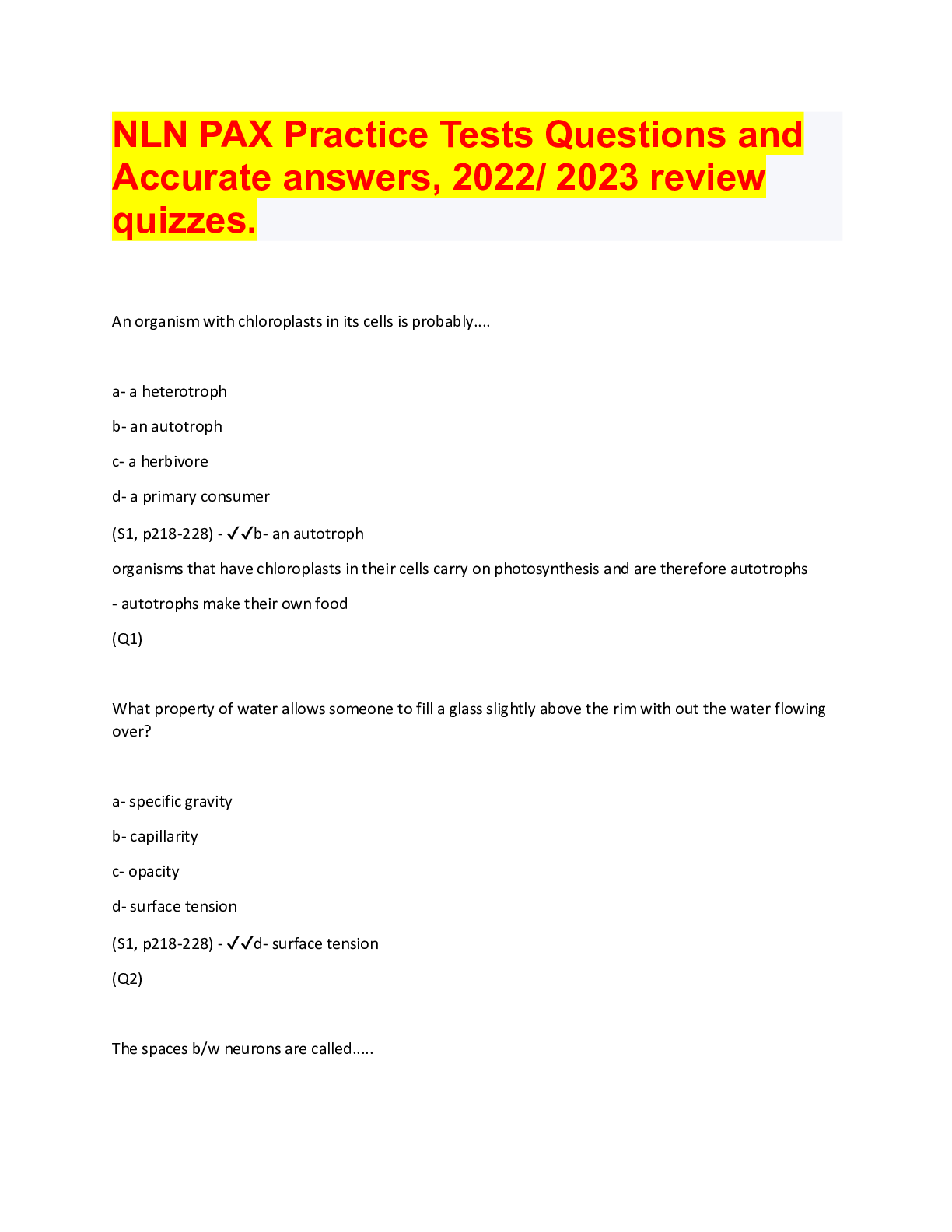
THE NLN EXAM BUNDLE. GRADED A+
ALL NLN EXAM QUESTIONS WITH ACCURATE ANSWERS, 2022
By bundleHub Solution guider 1 year ago
$34
14
Reviews( 0 )
Document information
Connected school, study & course
About the document
Uploaded On
Aug 12, 2022
Number of pages
37
Written in
Additional information
This document has been written for:
Uploaded
Aug 12, 2022
Downloads
0
Views
87














